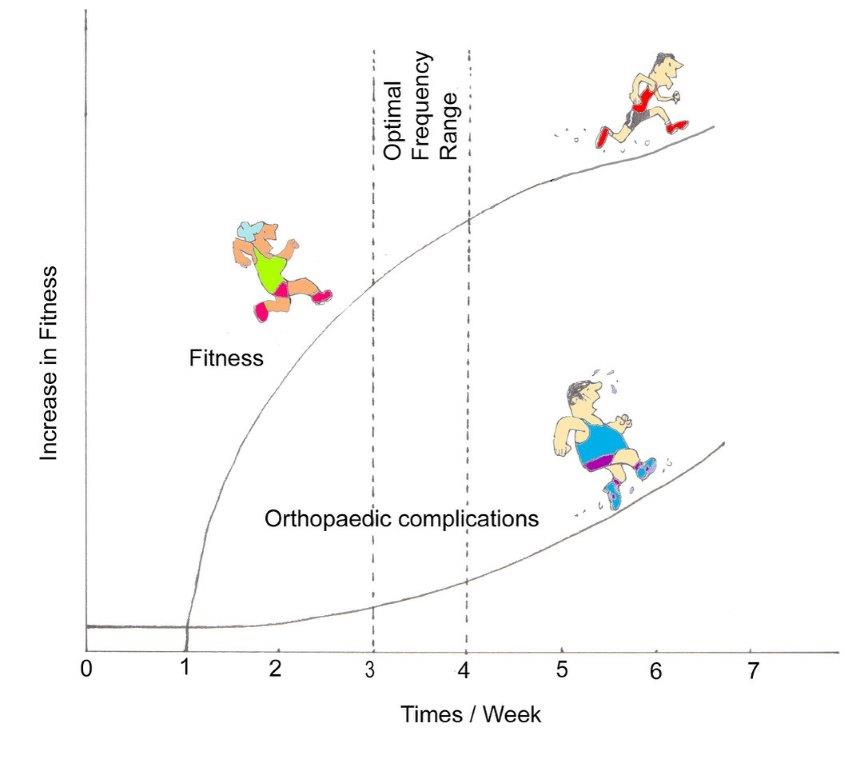How often, how hard, how long?
How much exercise do we need?
Here’s a quick guide – more or less applicable to any endurance exercise. The following graphs indicate the frequency, intensity and duration needed to increase your aerobic capacity – your cardiorespiratory fitness. These are sometimes known as the FITT principles – Frequency, Intensity, Time, Type of exercise:
Frequency – How often?
The graph at the head of this blog shows the relationship between exercise frequency and increase in fitness as measured by VO2max.
Exercising once per week has little effect, twice weekly a moderate effect, three or four times weekly a better effect but after that there is a fall-off in the benefit of more frequent training. Moreover the more often you train the greater is the risk of sprains and strains of joints and muscles.
Intensity – How hard?
This graph shows the relationship between intensity of exercise (as measured as the percentage of maximum heart rate reached) and increase in fitness as measured by VO2max.

Again, increasing effort brings increasing rewards but there is a point beyond which there is a reducing return. This point is reached at between roughly 70 and 85% maximum heart rate. For people with heart disease, exercising to very high heart rates brings an increased danger of complications, particularly disturbances of rhythm.
Just a word about heart rate. Your predicted maximum heart rate (PMHR) is about 220 minus your age. So 70% of PMHR is about 170 minus your age and 85% PMHR is about 195 minus your age. When you are exercising at between 70 and 85% PMHR you can just about talk with someone with you – you should be comfortably short of breath and not gasping. If you are taking any medication which might slow heart rate (beta-blockers, some calcium antagonists, ivabradine) these figures do not apply. You must rely on how hard it feels to exercise – see Borg scale or RPE below.
Time – How long?
This graph shows the relationship between duration of exercise sessions and increase in fitness as measured by VO2max.

There is a steady increase in physical fitness for increase in duration of exercise up to about 30 to 40 minutes but after that there is a flattening of the curve with less and less benefit for more and more time spent training. Again the more time you spend training the greater the risk of musculo-skeletal injury.
The total amount of dynamic aerobic activity can be expressed as “exercise volume,” which is the product of average METs multiplied by the time involved – in minutes. It has been suggested that the goal for maintaining good health should be between 500 and 1000 MET minutes per week. Take the example of walking at say 3.5mph. This uses about 6.4 METs so the target would take between 1 hour 18 mins (499 MET minutes) and 2 hours 36 minutes (998 Met minutes) of walking per week. If you are stepping out faster at, say 4mph (7.1 METs), the goal is reached with between 1 hour 10 minutes and 2 hours 20 minutes walking per week.
The rate of perceived exertion (RPE)
It is not easy to measure your own heart rate – as soon as you stop to feel your pulse, your heart rate slows. Pulse rate monitors can do it for you but many people prefer to rely on how hard the exercise feels to them. This is best done using the Rate or Perceived Exertion (RPE), devised by a Danish physiologist called Borg and often referred to as the Borg Scale.
0 None
0.5 Very very light
1 Very light
2 Light
3 Moderate
4 Somewhat heavy
5 Heavy
6
7 Very heavy
8
9 Very, very heavy
10
Predicted maximum heart rate usually reaches the 70 to 85% level at between numbers 4 and 6 on the scale. Try it and see.
Next week I will talk about the government guidelines.
Subscribe to the blog
Categories
- Accelerometer
- Alzheimer's disease
- Blood pressure
- BMI
- Cancer
- Complications
- Coronary disease
- Cycling
- Dementia
- Diabetes
- Events
- Evidence
- Exercise promotion
- Frailty
- Healthspan
- Hearty News
- Hypertension
- Ill effects
- Infections
- Lifespan
- Lipids
- Lung disease
- Mental health
- Mental health
- Muscles
- Obesity
- Osteoporosis
- Oxygen uptake
- Parkinson's Disease
- Physical activity
- Physical fitness
- Pregnancy
- Running
- Sedentary behaviour
- Strength training
- Stroke
- Uncategorized
- Walking



Exercise is an important factor in keeping fit and should be supplemented with a good diet always. Herbal tea is also an important factor during the fitness journey since it helps burn excess fats in the body and also boosts the metabolic rate in the body.
This is useful info for me as I have rejoined a gym now that they are open.